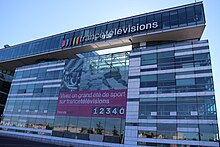France Télévisions
French national public television broadcaster From Wikipedia, the free encyclopedia
French national public television broadcaster From Wikipedia, the free encyclopedia
Logo used since 2022 | |
 France Télévisions headquarters in 2015 | |
| Company type | Société anonyme |
|---|---|
| Industry | Public service broadcasting |
| Founded | 7 September 1992 (as France Télévision)[a] 1 August 2000 (as France Télévisions SA) |
| Headquarters | 7 esplanade Henri de France Paris, Île-de-France, France |
Key people | Delphine Ernotte (Chairman) Patrice Duhamel (COO) |
| Products | |
| Services | |
| Revenue | |
| Total assets | |
| Owner | Government of France |
Number of employees | 9,050 (2021) |
| Subsidiaries | TV channels
Internet
Audiovisual production
Advertisement
Publishing and distribution
Others
|
| Website | https://www.francetelevisions.fr/ https://www.france.tv/ |
France Télévisions (French pronunciation: [fʁɑ̃s televizjɔ̃]; stylized since 2018 as france·tv) is the French national public television broadcaster. It is a state-owned company formed from the integration of the public television channels France 2 (formerly Antenne 2) and France 3 (formerly France Régions 3), later joined by the legally independent channels France 4 (formerly Festival), France 5 (formerly La Cinquième) and France Info.
France Télévisions is currently funded by the French Treasury and the revenue from commercial advertising. The new law on public broadcasting will phase out commercial advertising on the public television channels (at first in the evening, then gradually throughout the day).
France Télévisions is a supporter of the Hybrid Broadcast Broadband TV (HbbTV) initiative that is promoting and establishing an open European standard for hybrid set-top boxes for the reception of broadcast TV and broadband multimedia applications with a single user interface, and has selected HbbTV for its interactive news, sports and weather service, and plans to add catch-up TV and social media sharing capability.[2]
From 1964 to 1975, French radio and television was monopolized through an organization known as the Office de Radiodiffusion Télévision Française. In an effort to stimulate competition, the organization was split in 1975 so that France's three television channels—TF1, Antenne 2, and FR3, would still be owned by the French government, but be operated independently from each other. However, the sale of TF1 to Bouygues in 1987 and increased competition from other new private broadcasters (such as Canal+ and La Cinq, the latter having been replaced by public channel La Cinquième after it ceased transmissions in April 1992) led to a decline in viewership for the two remaining public channels, which lost 30% of their market share between 1987 and 1989.[3][4] The channels were however saved when a single director-general was appointed to manage both Antenne 2 and FR3, becoming part of a joint entity known as France Télévision. They were renamed in 1992 as France 2 and France 3, respectively.[5]
In August 2000, France Télévisions S.A. was formed as a holding company for France's public television channels, absorbing control of France 2, France 3, and La Cinquième (later renamed France 5). In 2004, Réseau France Outre-mer was absorbed by France Télévisions. Beginning in 2008, the President of France took the duty of naming the presidents for the French public broadcasters; they were previously nominated by the Conseil supérieur de l'audiovisuel. In 2013, under Francois Hollande, the previously adopted law was modified to return the power to nominate the presidents or French public broadcasters to the Conseil supérieur de l'audiovisuel.

France Télévisions has an interest in a number of thematic cable/satellite channels in France:
| Channel | France Télévisions | Indirect interest | Other interest | |
|---|---|---|---|---|
| Planète+ Crime | 34% | 66% Canal+ Thématiques (Canal+ Group) | ||
France Télévisions holds 100% of France Télémusique SAS.
The thematic channel Planète Juniors (formerly Ma Planète) ceased operations in March 2009.
| Channel | France Télévisions | Indirect interest | Other interest | |
|---|---|---|---|---|
| TV5Monde | 46.42% | 3.12% | Arte France | France Médias Monde 11.97% RTS 10.53% RTBF 10.53% CBC 6.32% TVMonaco 5.26% Télé-Québec 4.21% INA 1.65% |
| Arte | 50.00% | Arte France | 50% Arte Deutschland TV GmbH (ARD and ZDF) | |
France Télévisions holds 45% of the Arte France holding company together with the French state (25%), Radio France (15%) and INA (15%). Arte France and Arte Deutschland form the Arte Consortium that manages the bilingual French-German channel (Arte shared its analogue channel with France 5, but both channels have separate full-time services on cable, satellite and digital broadcasts).
France Télévisions also controls the new R1 digital multiplex that currently hosts France 2, France 3, France 5, Arte and La Chaîne parlementaire. France 4 was originally on the R1 multiplex but was moved to R2 to allow space for regional channels on R1.
Seamless Wikipedia browsing. On steroids.
Every time you click a link to Wikipedia, Wiktionary or Wikiquote in your browser's search results, it will show the modern Wikiwand interface.
Wikiwand extension is a five stars, simple, with minimum permission required to keep your browsing private, safe and transparent.